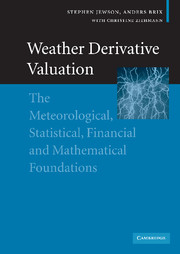 Weather Derivative Valuation
Weather Derivative Valuation Book contents
- Frontmatter
- Contents
- List of figures
- List of tables
- Acknowledgements
- 1 Weather derivatives and the weather derivatives market
- 2 Data cleaning and trends
- 3 The valuation of single contracts using burn analysis
- 4 The valuation of single contracts using index modelling
- 5 Further topics in the valuation of single contracts
- 6 The valuation of single contracts using daily modelling
- 7 Modelling portfolios
- 8 Managing portfolios
- 9 An introduction to meteorological forecasts
- 10 The use of meteorological forecasts in pricing
- 11 Arbitrage pricing models
- 12 Risk management
- 13 Modelling non-temperature data
- A Trend models
- B Parameter estimation
- C Goodness of fit tests
- D Expected pay-offs for normally distributed indices
- E Pay-off variances for normally distributed indices
- F Greeks for normally distributed indices
- G Exact solutions for the kernel density
- H The beta for a normally distributed index
- I Simulation methods
- J Efficient methods for pricing against a portfolio
- References
- Index
3 - The valuation of single contracts using burn analysis
Published online by Cambridge University Press: 22 September 2009
- Frontmatter
- Contents
- List of figures
- List of tables
- Acknowledgements
- 1 Weather derivatives and the weather derivatives market
- 2 Data cleaning and trends
- 3 The valuation of single contracts using burn analysis
- 4 The valuation of single contracts using index modelling
- 5 Further topics in the valuation of single contracts
- 6 The valuation of single contracts using daily modelling
- 7 Modelling portfolios
- 8 Managing portfolios
- 9 An introduction to meteorological forecasts
- 10 The use of meteorological forecasts in pricing
- 11 Arbitrage pricing models
- 12 Risk management
- 13 Modelling non-temperature data
- A Trend models
- B Parameter estimation
- C Goodness of fit tests
- D Expected pay-offs for normally distributed indices
- E Pay-off variances for normally distributed indices
- F Greeks for normally distributed indices
- G Exact solutions for the kernel density
- H The beta for a normally distributed index
- I Simulation methods
- J Efficient methods for pricing against a portfolio
- References
- Index
Summary
We saw in the introductory chapter that, in most cases, weather derivative pricing is based on actuarial methods that estimate the probabilities of the various financial outcomes of a contract or a portfolio of contracts. In this chapter we explore the most straightforward method by which the prices and the distribution of financial outcomes of individual contracts can be estimated, which is burn analysis. We also investigate the level of uncertainty inherent in such estimates.
Burn analysis
Burn analysis, or just ‘burn’, is based, very simply, on the idea of evaluating how a contract would have performed in previous years. In its most straightforward form there is nothing more to it, and as a result it can be calculated, quite literally, with pencil and paper – or, slightly more practically, in a simple spreadsheet. We extend this basic form of burn to include those cases where we also detrend the data prior to evaluating how the contract would have performed. Burn explicitly does not include fitting distributions and using Monte Carlo simulations, however.
Although there are cases when other methods may be more accurate or give more information, burn analysis is nevertheless a good first step in pricing almost any contract. We will describe the steps involved in burn analysis for swaps and options, and then give some examples.
Burn analysis for swaps
Estimating the fair strike for linear swaps
The fair strike for a swap is defined as that strike that gives an expected pay-off of zero.
- Type
- Chapter
- Information
- Weather Derivative ValuationThe Meteorological, Statistical, Financial and Mathematical Foundations, pp. 59 - 72Publisher: Cambridge University PressPrint publication year: 2005


